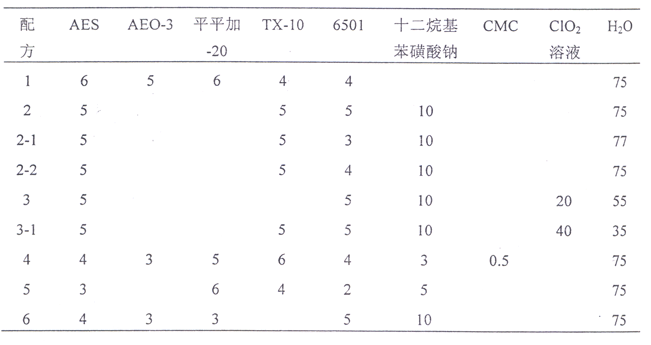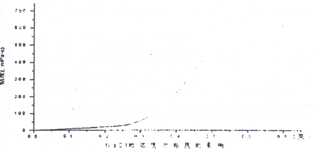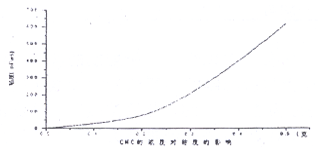Abstract: The effects of chlorine dioxide on the foaming power, detergency, viscosity, surface tension and bactericidal activity of liquid detergents were studied. The optimal ClO2 ratio was found by compounding and screening. Chlorine dioxide has certain viscosity enhancement to liquid detergents, and at the same time, it has enhanced detergency, reduced surface tension, increased foaming power and increased disinfection and sterilization functions for liquid detergents. When the concentration of chlorine dioxide is 4mg/mL, the performance of the liquid detergent is ideal, the detergency is 1/4--1/3 higher than the general ratio, the pH is 7.0--8.0, and the viscosity is 600--640mPa.s. The foaming power is 150--160mm, and the number of decontamination plates is 22 sets, which has good sterilization and disinfection ability.
Key words: stable chlorine dioxide; sterilization; liquid detergent; viscosity; disinfectant
Chlorine dioxide (clo2) was discovered in 1811 by Humphry Davy, which is a yellow, yellow-green gas at room temperature. It has an irritating gas similar to chlorine and ozone. It can be condensed into a deep red liquid below 11 °C. Because the molecule contains an odd number of electrons, it has a high chemical activity, its oxidizing ability is 2.6 times that of oxygen, and the disinfecting effect is 5 times that of chlorine [1]. Since the 1940s, clo2 has been widely used in pulp bleaching, sterilization, deodorization, water purification, and waste disposal. Success has swept the new generation of disinfectants in Europe, the United States, Japan and other developed countries, with high efficiency, broad spectrum, fast, harmless to the human body and the environment. A Japanese company compounded chlorine dioxide and surfactant into a liquid decontaminator, which has a good function of washing and disinfecting. In China, chlorine dioxide is mainly used in the water treatment and paper industry. Decontaminants are still to be further processed. The new varieties of detergents developed have great development prospects. This paper mainly introduces the properties of chlorine dioxide, its preparation method and its application, and it is compounded with liquid detergent to produce a liquid disinfectant with excellent performance. The characteristics of chlorine dioxide in liquid detergent are also investigated.
1 Experimental part
1.1 Reagents and instruments
LAS dodecylbenzenesulfonic acid (Jinling Petrochemical Company Nanjing alkylbenzene plant): 6501 (1:1) (Changzhou Taihua Chemical Co., Ltd.); AES (Xi'an Daily Chemical Industry Company); AEO-3 (100 %)(Henan Province Weida Chemical Co., Ltd.); TX-10 (99.6%) (Shanghai Xingxi Chemical Co., Ltd.); Pingping Plus-20 (Xi'an Petrochemical Plant); stable chlorine dioxide solution (2.03%) (Xi'an) Institute of Mechanical and Electrical Information); p-xylene, ethanol, sodium carboxymethylcellulose, sodium chloride, anhydrous calcium chloride, MgCl2.7H2O, sodium hydroxide, etc. are all reagent grade.
PHS-3C precision pH meter (manufactured by Shanghai Lei Magnetic Instrument Factory); rotary viscometer NDJ-79 (produced by Tongji University machine power plant); JZHY-180 interface tension meter (manufactured by Chengde Experimental Machine Co., Ltd.); Ross-foam meter.
1.2 Experimental steps
Add a certain amount of water to a 500 mL three-necked flask, add AES at a certain temperature, keep the temperature constant and stir until AES is completely dissolved; then add other surfactants such as 6501, AEO, TX-10, OP-10, Sodium dodecylbenzenesulfonate, pingping plus -20, etc., stirring to make the surfactant evenly mixed, cooling and cooling. After the temperature is lowered, it is compounded with a certain amount of chlorine dioxide solution, and then the sodium hydroxymethylcellulose sodium chloride is added to adjust the viscosity of the detergent to a predetermined viscosity.
2 Results and discussion
2.1 Formulation design of the product

2.2 Solid content
It can be seen from the data in Table 2 that the solid content of the prepared sample detergent reaches the level of detergent on the market, between the scented detergent and the singular detergent, which indicates the surfactant and the corresponding auxiliary in the sample. The dosage is equivalent to that of the scented detergent and the odd-strong detergent.
2.3 Detergent foaming power
According to the method for detecting the foaming force, the test was carried out at room temperature (about 24 ° C), and the hardness of the water and the concentration of the test solution were prepared in strict accordance with the national standard. The results are shown in Table 3.
Table 2 Solid content and water and volatile matter content

Table 3 foaming power of each sample

The results in Table 3 show that the best-selling products on the market (Qiqiang, Engraved Cleaner) have good foaming power and are rich in foam when washed. From the measured data, detergents containing only nonionic surfactants and a small amount of auxiliaries have relatively low foaming power, are not rich in foam and are not fine, loose and unstable, and contain anionic surface active agents. The detergent of the agent and the nonionic surfactant has a high foaming power, and the foam is stable and fine.
In addition, the foaming power of the detergent to which chlorine dioxide is added does not increase as the concentration of chlorine dioxide increases. When the concentration of chlorine dioxide is lowered, the foaming power is increased; when the content of chlorine dioxide is high, the foaming power is decreased. Therefore, in order to obtain a foam-rich net detergent, the concentration of chlorine dioxide should be formulated to be lower; conversely, a detergent having a higher chlorine dioxide content can be prepared.
2.4 Surface tension
The data in Table 4 shows that the surface tension of the samples prepared in this experiment is similar to that of the detergent on the market, especially the surface tension of Formula 3 is slightly lower than that of Qiqiang and Engraved detergent. From this point, it can be known that the detergent made of Formula 3 is superior to the combination of dirt and oil stains, and is superior to the brand-name cleaner.
Table 4 Surface tension of several samples

2.5 Viscosity
2.5.1 Viscosity of several samples
6501, NaCl and CMC have viscosity-increasing liquid detergents and their respective characteristics are different. Here, the effects of 6501, NaCl and CMC on the viscosity of the liquid detergent are discussed. The results are shown in Table 5.
Table 5 Viscosity of each sample

As can be seen from Table 5, the viscosity of the prepared samples can be higher or lower than that of the commercially available detergents, so that detergents of different viscosities can be prepared according to the environment and actual needs. At the same time, chlorine dioxide has a certain viscosity, but does not increase with the concentration of chlorine dioxide, but has a highest point.
2.5.2 Effect of 6501 on product viscosity
It can be seen from Fig. 1 that when the concentration of 6501 is small, the viscosity of the liquid detergent does not change much; but when the amount is increased to 4%, the viscosity increases rapidly with the increase of the amount of 6501, and at this time, The resulting liquid detergent has the best transparency, the solution is not delaminated, is not turbid, and has a good washing ability. Therefore, the amount of 6501 should be more than 5% when formulated.

Figure 1 Effect of the amount of 6501 on viscosity
2.5.3 Effect of NaCl on product viscosity
It can be seen from Fig. 2 that when the concentration of NaCl is more than 3%, the viscosity of the liquid detergent changes relatively with the increase of the amount of the liquid; when the amount reaches 6%, the viscosity of the liquid detergent decreases. When the surface NaCl adjusts the viscosity, it should not be added too much, because the viscosity of NaCl is changed by changing the electrical properties of the liquid detergent, and there is an electrical balance with the surfactant; before the electrical balance is reached, the NaCl is applied to the detergent. There is viscosity increase; after reaching the electrical balance, the addition of NaCl is an example of inorganic salt destructive force. The surfactant is electroviscous due to electrical balance, and the viscosity decreases.
2.5.4 Effect of CMC on sample viscosity
As can be seen from Fig. 3, when the concentration of CMC reaches 2% or more, there is a mutation in the viscosity of the liquid detergent, but adding too much CMC (0.4 g/100 mL), the liquid detergent configured becomes opaque. It is turbid, stratified, and flocculated, which affects the appearance of liquid detergents. Therefore, it is not an ideal choice to adjust the viscosity of liquid detergents with CMC.

Figure 2 Effect of the amount of NaCl on viscosity

Figure 3 Effect of the amount of CMC on the viscosity
2.6 Decontamination performance
Due to experimental conditions, and for convenience, we used a large number of artificial glass slides to compare the decontamination ability of the samples and the best-selling products on the market (carved detergent, odd-strong detergent). The results are shown in Table 6.
Table 6 Detergency of different samples

The data in Table 6 shows that the detergency of the detergent after adding chlorine dioxide is much stronger than that of the conventional formula, which is consistent with the data. Detergents containing an anion indicating that the active agent are more detergent than detergents containing only nonionic agents. It can be seen that chlorine dioxide and the active agent do have a "synergy" effect, which can enhance the washing effect. Under the same conditions, detergents containing chlorine dioxide can reduce their dosage and are more decontaminating than detergents on the market.
2.7 Detergent bactericidal
The ability of the disinfectant to sterilize in the military is determined by the size of the inhibition zone, that is, the cultured strain is prepared on a glass piece, and then a drop of the solution is applied to the strain, and the range of the dried tea bacteria under the microscope is Also note the diameter of the next circle, the size of the so-called inhibition zone. The bactericidal properties of different samples were tested, and the results are shown in Table 7.
Table 7 Sterilization effect of different samples (size of inhibition zone)

It can be seen from Table 7 that the prepared detergent disinfectant has a good sterilization and disinfection function, and its sterilization and disinfection ability is proportional to the concentration of the prepared diluent. The higher the concentration, the better the sterilization and disinfection ability [3]; At a pH of between 2 and 8, the change in the sterilizing power of the detergent disinfectant was small at the same concentration, indicating that the effect of pH on the disinfecting ability of ClO2 was not large.
3 Conclusion
2.1 Formulation design of the product
In the experiment, liquid disinfectant detergents with different compositions were synthesized, which have different characteristics: Formulation 1 has low foaming characteristics and is suitable for washing dishes, fruits and vegetables; Formulation 2 has medium foam, high viscosity and strong detergency. The characteristics are suitable for machine washing of tableware and clothes; Formula 3 has the characteristics of high foaming power, high viscosity, high detergency, strong sterilization and disinfection, suitable for disinfection and washing of tableware, infection of patient clothes and disinfection of hotels and restaurants. And other industries that require disinfection and washing. Formulations 4, 5, and 6 all have high foaming, medium viscosity, and strong detergency. They are suitable for washing laundry, fruit, and tableware.
In short, chlorine dioxide and surfactant are compounded into liquid decontaminants, which have good detergency, washing and disinfecting functions, and have a good market prospect.





